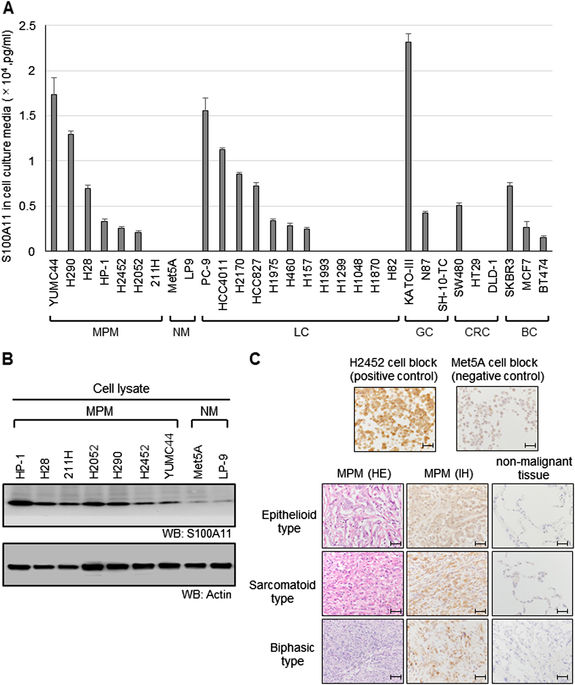当前位置:
X-MOL 学术
›
Oncogenesis
›
论文详情
Our official English website, www.x-mol.net, welcomes your
feedback! (Note: you will need to create a separate account there.)
Therapeutic potential of targeting S100A11 in malignant pleural mesothelioma.
Oncogenesis ( IF 5.9 ) Pub Date : 2018-Jan-24 , DOI: 10.1038/s41389-017-0017-3 Hiroki Sato , Masakiyo Sakaguchi , Hiromasa Yamamoto , Shuta Tomida , Keisuke Aoe , Kazuhiko Shien , Takahiro Yoshioka , Kei Namba , Hidejiro Torigoe , Junichi Soh , Kazunori Tsukuda , Hiroyuki Tao , Kazunori Okabe , Shinichiro Miyoshi , Harvey I. Pass , Shinichi Toyooka
Oncogenesis ( IF 5.9 ) Pub Date : 2018-Jan-24 , DOI: 10.1038/s41389-017-0017-3 Hiroki Sato , Masakiyo Sakaguchi , Hiromasa Yamamoto , Shuta Tomida , Keisuke Aoe , Kazuhiko Shien , Takahiro Yoshioka , Kei Namba , Hidejiro Torigoe , Junichi Soh , Kazunori Tsukuda , Hiroyuki Tao , Kazunori Okabe , Shinichiro Miyoshi , Harvey I. Pass , Shinichi Toyooka

|
Malignant pleural mesothelioma (MPM) is an aggressive tumor with an unfavorable prognosis. The standard therapeutic approaches are limited to surgery, chemotherapy, and radiotherapy. Because the consequent clinical outcome is often unsatisfactory, a different approach in MPM treatment is required. S100A11, a Ca2+-binding small protein with two EF-hands, is frequently upregulated in various human cancers. Interestingly, it has been found that intracellular and extracellular S100A11 have different functions in cell viability. In this study, we focused on the impact of extracellular S100A11 in MPM and explored the therapeutic potential of an S100A11-targeting strategy. We examined the secretion level of S100A11 in various kinds of cell lines by enzyme-linked immunosorbent assay. Among them, six out of seven MPM cell lines actively secreted S100A11, whereas normal mesothelial cell lines did not secrete it. To investigate the role of secreted S100A11 in MPM, we inhibited its function by neutralizing S100A11 with an anti-S100A11 antibody. Interestingly, the antibody significantly inhibited the proliferation of S100A11-secreting MPM cells in vitro and in vivo. Microarray analysis revealed that several pathways including genes involved in cell proliferation were negatively enriched in the antibody-treated cell lines. In addition, we examined the secretion level of S100A11 in various types of pleural effusions. We found that the secretion of S100A11 was significantly higher in MPM pleural effusions, compared to others, suggesting the possibility for the use of S100A11 as a biomarker. In conclusion, our results indicate that extracellular S100A11 plays important roles in MPM and may be a therapeutic target in S100A11-secreting MPM.
中文翻译:

靶向S100A11在恶性胸膜间皮瘤中的治疗潜力。
恶性胸膜间皮瘤(MPM)是一种侵袭性肿瘤,预后不良。标准治疗方法仅限于手术,化学疗法和放射疗法。由于随之而来的临床结果通常不尽人意,因此需要在MPM治疗中采用其他方法。S100A11,Ca 2+在两种人类癌症中,经常用两个EF手结合小蛋白结合小分子。有趣的是,已经发现细胞内和细胞外S100A11在细胞活力方面具有不同的功能。在这项研究中,我们集中于细胞外S100A11在MPM中的影响,并探索了S100A11靶向策略的治疗潜力。我们通过酶联免疫吸附法检测了S100A11在各种细胞系中的分泌水平。其中,七个MPM细胞系中有六个活跃地分泌S100A11,而正常的间皮细胞系则不分泌它。为了研究分泌的S100A11在MPM中的作用,我们通过用抗S100A11抗体中和S100A11来抑制其功能。有趣的是,该抗体在体外和体内均显着抑制分泌S100A11的MPM细胞的增殖。微阵列分析显示,在抗体处理的细胞系中,包括与细胞增殖有关的基因在内的几种途径都负向富集。此外,我们检查了S100A11在各种类型的胸腔积液中的分泌水平。我们发现,与其他相比,MPM胸腔积液中S100A11的分泌明显更高,这表明使用S100A11作为生物标志物的可能性。总之,我们的结果表明,细胞外S100A11在MPM中起重要作用,并且可能是分泌S100A11的MPM的治疗靶标。我们发现,与其他相比,MPM胸腔积液中S100A11的分泌明显更高,这表明使用S100A11作为生物标志物的可能性。总之,我们的结果表明,细胞外S100A11在MPM中起重要作用,并且可能是分泌S100A11的MPM的治疗靶标。我们发现,与其他相比,MPM胸腔积液中S100A11的分泌明显更高,这表明使用S100A11作为生物标志物的可能性。总之,我们的结果表明,细胞外S100A11在MPM中起重要作用,并且可能是分泌S100A11的MPM的治疗靶标。
更新日期:2018-02-09
中文翻译:

靶向S100A11在恶性胸膜间皮瘤中的治疗潜力。
恶性胸膜间皮瘤(MPM)是一种侵袭性肿瘤,预后不良。标准治疗方法仅限于手术,化学疗法和放射疗法。由于随之而来的临床结果通常不尽人意,因此需要在MPM治疗中采用其他方法。S100A11,Ca 2+在两种人类癌症中,经常用两个EF手结合小蛋白结合小分子。有趣的是,已经发现细胞内和细胞外S100A11在细胞活力方面具有不同的功能。在这项研究中,我们集中于细胞外S100A11在MPM中的影响,并探索了S100A11靶向策略的治疗潜力。我们通过酶联免疫吸附法检测了S100A11在各种细胞系中的分泌水平。其中,七个MPM细胞系中有六个活跃地分泌S100A11,而正常的间皮细胞系则不分泌它。为了研究分泌的S100A11在MPM中的作用,我们通过用抗S100A11抗体中和S100A11来抑制其功能。有趣的是,该抗体在体外和体内均显着抑制分泌S100A11的MPM细胞的增殖。微阵列分析显示,在抗体处理的细胞系中,包括与细胞增殖有关的基因在内的几种途径都负向富集。此外,我们检查了S100A11在各种类型的胸腔积液中的分泌水平。我们发现,与其他相比,MPM胸腔积液中S100A11的分泌明显更高,这表明使用S100A11作为生物标志物的可能性。总之,我们的结果表明,细胞外S100A11在MPM中起重要作用,并且可能是分泌S100A11的MPM的治疗靶标。我们发现,与其他相比,MPM胸腔积液中S100A11的分泌明显更高,这表明使用S100A11作为生物标志物的可能性。总之,我们的结果表明,细胞外S100A11在MPM中起重要作用,并且可能是分泌S100A11的MPM的治疗靶标。我们发现,与其他相比,MPM胸腔积液中S100A11的分泌明显更高,这表明使用S100A11作为生物标志物的可能性。总之,我们的结果表明,细胞外S100A11在MPM中起重要作用,并且可能是分泌S100A11的MPM的治疗靶标。













































 京公网安备 11010802027423号
京公网安备 11010802027423号